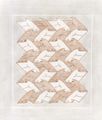Math and Escher and the Saint Louis University Prison Program
Saint Louis University's Prison Program is an educational program for both inmates and staff. Math and the Art of Escher is one of the courses offered and the work shown on this page represents some of the mathematical artwork produced during the nine week course at the ERDCC in Bonne Terre, Missouri. The work shown here is from the inmate class.
Several works are highlighted and discussed in more detail. The materials are organized according to the types of patterns created: Rosette, Border, and Wallpaper Patterns. Towards the bottom of the page are several galleries showing the works from this course. The galleries are clickable.
Rosette Patterns
The Rosette patterns are finite motifs classified by the reflections they may or may not have and the order of the rotation. The rosettes created varied from the abstract to more representational. The students turned in sketches to show the design process and wrote a paper explaining the mathematics used to create the design.

|

|
| The sketches showing the design of the symmetries. | Ocean Treasures by J. Wooldridge |
Another student created a pattern based on nested interlocking squares. This idea was also explored by M.C. Escher.

|

|
| M.C. Escher's Regular division of the plane by similar figures of which size and contents rhythmically diminish in size, receding toward the center 1941?. |
Rosette by C. Gardner |
These rosette patterns are also fractals. The images are self-similar. It contains copies of itself at different scales. In this example the same shape - the interlocking squares - appear to repeat and recede into the center of the image. The repetition and the scaling creates an illusion of depth and infinity. The student image has a scaling factor of 1/√2 as we proceed towards the center of the image.
One of the projects combined a music theme across the artwork. J. McCollom explained how flatpicking and fiddle tunes for guitars inspired him to create a rosette combining the images of the guitar and the pick. In the border pattern the pick and guitar string were reduced to an abstract very symmetric depiction.

|

|
| Guitar and Plectrum by J. McCollom | Guitar String with collection of Plectrums |
Border Patterns
The border patterns varied from abstract to representational.

The border depicting three celtic crosses combines several mathematical examples from class. The Celtic Crosses show knot work designs. The over-under crossings tend to break symmetry. In this case there is no reflectional or rotational symmetry and what remains is the translational symmetry ("shifts") that map one cross to another. The interpretation of these crosses representing the Father, the Son and the Holy Ghost is interesting in that light.

The print named Pinwheels shows an intricate design. The print was developed using grid paper. The arches were created using a collection of straight lines. Such surfaces are called ruled surfaces.
Tessellations
The tessellations varied from interesting designs that show a theme such as Love over Hate by C. Riley, to a design based on prints by Escher, to tessellations based on recognizable figures.

|

|
| Regelmatige Vlakverdeling, Plate I by M.C. Escher (1957) | Quackers a print by J. Wooldridge |
R. Scott's print Dragon Heads shows dragon heads in three colors. The black and white components are created with charcoal, and the grey heads are created by the negative space and are in the grey color of the paper used. The design shows a three fold rotation, but no reflectional symmetry.

Gallery of Rosette Designs
-
R. Scott Ink on paper C4 symmetry.
-
C. Gardner Cutout paper D8 symmetry.
-
J. Wooldridge Stars D5 symmetry
-
A. Cole
-
C. Gardner D8 symmetry
-
P. Cote Baseball C3 symmetry
-
C. Everett Roses and Rings C2 symmetry
-
J McCollom Guitars D4 symmetry
-
M. Tripp Snowmen C3 symmetry
-
E. Webb
-
J. Wooldridge Pennsylvania Dutch (Hex sign) C5 symmetry
-
T. McDermott C1 symmetry
Gallery of Border Pattern Designs
-
C. Riley Love over Hate p112 symmetry.
-
R. Scott. Owls pm11 symmetry.
-
R. Schmit. Pinwheels
-
A Cole Mayan design pma2 symmetry.
-
J Comfort Geometric Design pmm2 symmetry.
-
P. Cote Father, Son and the Holy Ghost p111 symmetry.
-
C. Everett p1m1 symmetry.
-
J McCollum Plectrum and Guitar string pmm2 symmetry.
-
R. Schmit Gridlock p112 symmetry.
-
E. Webb
-
T. McDermott Chess Pieces pma2 symmetry.
-
D. Thorne
Gallery of Wallpaper Patterns
-
J. Wooldridge
-
M. Tripp Bears
-
C. Everett Birds
-
D. Thorne Birds
-
T. McDermott Birds
-
J. McCollom Bugs
-
C. Gardner Cat and Fish
-
J Comfort
-
E. Webb Frogs and Flies
-
A. Cole Dog eat Dog p4 symmetry.
-
R. Scott Dragons Charcoal on grey paper. p3 symmetry.
-
C. Riley Love over Hate
-
P. Cote St Francis Birds p1 symmetry.
-
R. Schmit Tazza/Silhouette pmm symmetry.
-
J. Comfort Veterans p2 symmetry.
-
C. Riley Winged Things

































